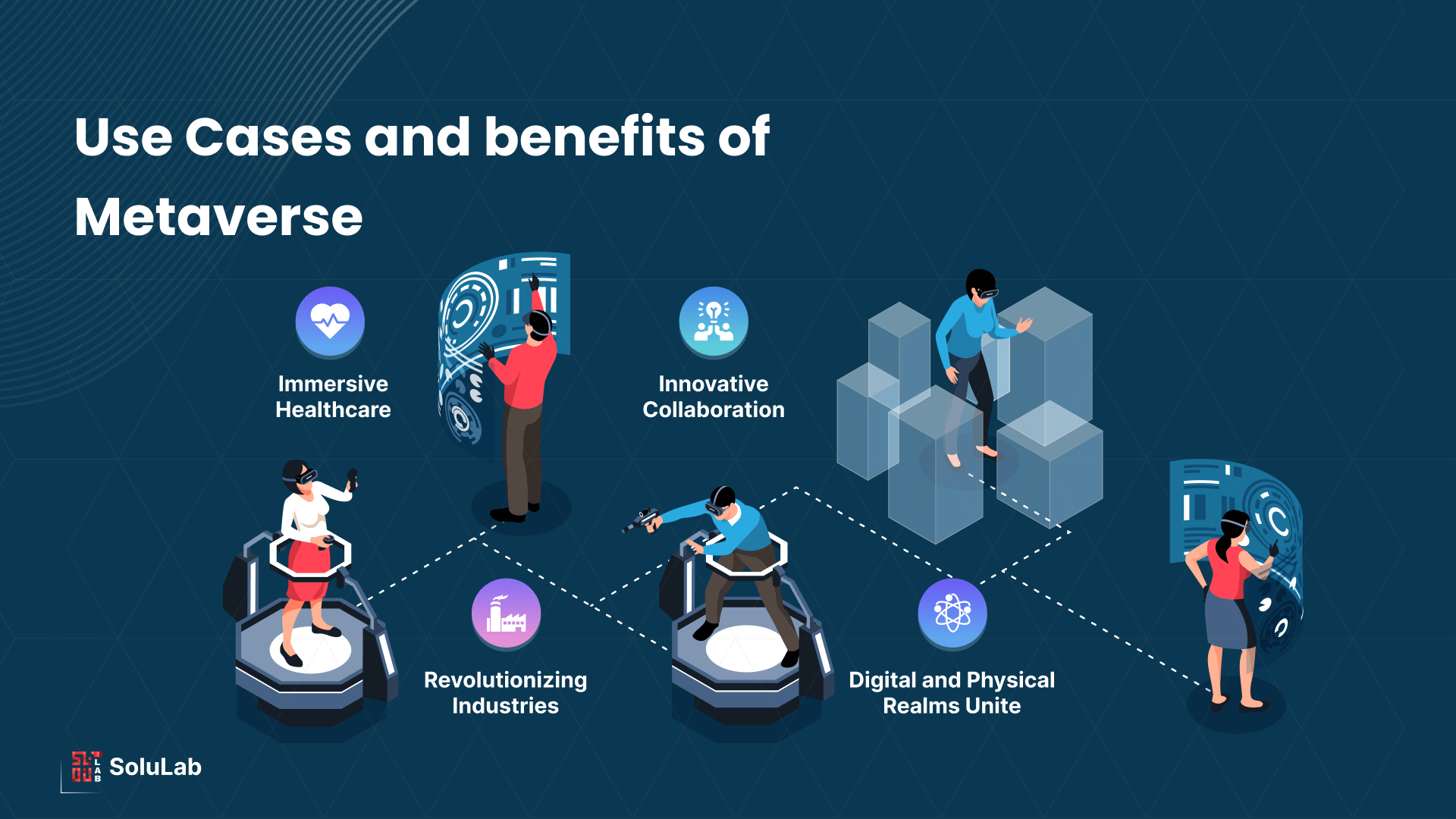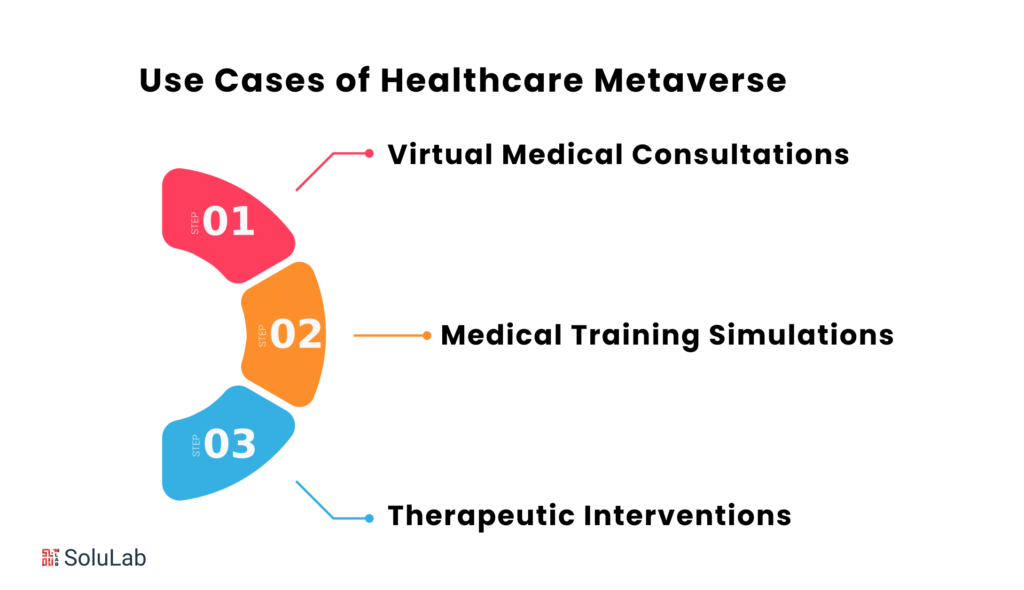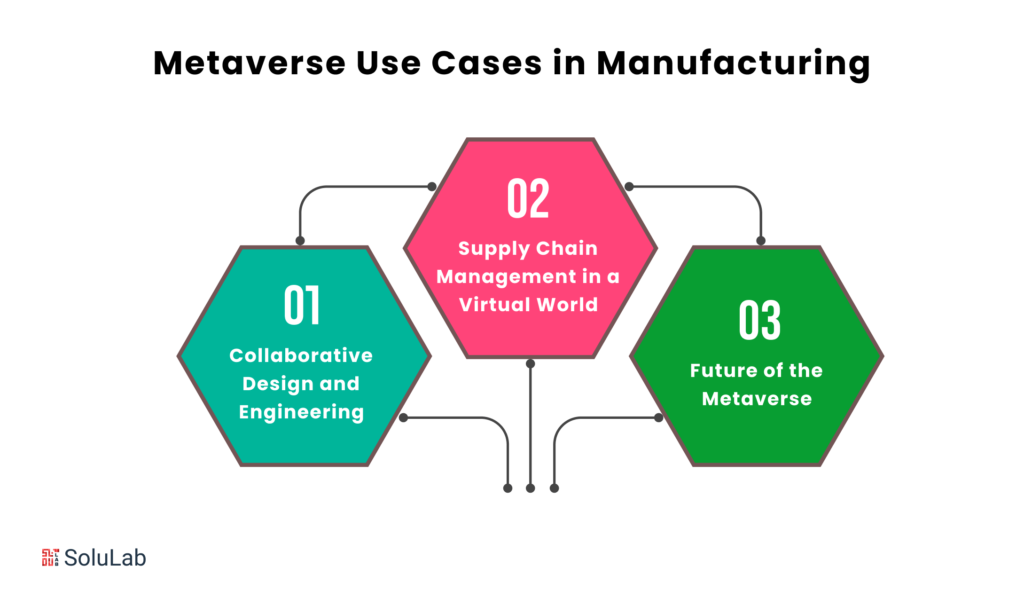
The Metaverse, a convergence of physical and digital realities, has the potential to revolutionize many industries. This exploration will examine a variety of Metaverse use cases across industries, highlighting the ways in which virtual and physical realms can be mutually beneficial.
One of the most promising Metaverse use cases is in the healthcare industry. Virtual reality (VR) and augmented reality (AR) can be used to create immersive experiences that can help patients with a variety of conditions. For example, VR can be used to create realistic simulations of surgical procedures, which can help surgeons to practice and improve their skills. AR can be used to provide patients with real-time information about their condition, which can help them to better understand their treatment and make informed decisions.
The Metaverse can also be used to improve education. VR and AR can be used to create immersive learning experiences that can make it easier for students to understand complex concepts. For example, VR can be used to create simulations of historical events or natural disasters, which can help students to develop a better understanding of the world around them. AR can be used to provide students with real-time information about their surroundings, which can help them to learn more effectively.
The Metaverse has the potential to transform the way we work. VR and AR can be used to create collaborative workspaces that allow people to work together from anywhere in the world. This can improve productivity and reduce travel costs. VR can also be used to create simulations of real-world environments, which can help employees to learn new skills and improve their performance.
The Metaverse can also be used to create new forms of entertainment. VR and AR can be used to create immersive experiences that can transport users to new worlds. This can make for more engaging and immersive entertainment experiences.
The Metaverse is still in its early stages of development, but it has the potential to revolutionize many industries. By merging physical and digital realities, the Metaverse can create new opportunities for businesses and consumers alike.
Related: Guide on 7 Layers of the Metaverse
Understanding Metaverse Use Cases
In the expansive landscape of the Metaverse, use cases are manifold. From education and entertainment to commerce and beyond, the Metaverse offers a myriad of applications. Its versatility lies in its ability to bridge geographical gaps, foster collaboration, and create immersive experiences for users.
For example, in the education sector, the Metaverse can be used to create virtual classrooms that allow students from all over the world to learn together. This can be a great way to reduce barriers to education and provide students with access to a wider range of learning opportunities. Additionally, the Metaverse can be used to create interactive simulations and games that can help students learn in a more engaging way.
In the entertainment sector, the Metaverse can be used to create immersive virtual worlds where users can interact with each other and explore new environments. This can be a great way to escape from the real world and have fun with friends. Additionally, the Metaverse can be used to create new forms of entertainment, such as concerts and sporting events, that can be enjoyed by people all over the world.
In the commerce sector, the Metaverse can be used to create virtual stores where users can shop for products and services. This can be a great way for businesses to reach new customers and expand their reach. Additionally, the Metaverse can be used to create new forms of customer engagement, such as virtual product demos and customer service.
These are just a few examples of the many ways that the Metaverse can be used. As the technology continues to develop, we can expect to see even more innovative and creative applications for the Metaverse in the years to come.
Benefits of the Metaverse
The benefits of the Metaverse extend beyond virtual realms. Enhanced collaboration, connectivity, and economic opportunities define the Metaverse’s positive impact. Users experience a new dimension of interconnectedness, ushering in an era where physical and virtual realities converge seamlessly.
- Enhanced collaboration: The Metaverse allows people from all over the world to collaborate in real time, regardless of their physical location. This can be a game-changer for businesses, as it allows teams to work together more efficiently and effectively. For example, a team of designers could collaborate on a new product design, or a team of engineers could collaborate on a new software development project.
- Connectivity: The Metaverse also provides a new way for people to connect with each other. For example, people can attend virtual concerts, sporting events, or even parties. This can be a great way for people to stay connected with friends and family who live far away.
- Economic opportunities: The Metaverse also creates new economic opportunities. For example, businesses can sell virtual goods and services, or they can charge users for access to their virtual worlds. This can be a lucrative business, as the Metaverse is expected to grow to a multi-trillion dollar market in the coming years.
The Metaverse is still in its early stages of development, but it has the potential to revolutionize the way we live, work, and play. By providing new ways for people to collaborate, connect, and create, the Metaverse has the potential to make the world a more interconnected and prosperous place.
Healthcare Metaverse Use Cases

In healthcare, the Metaverse emerges as a catalyst for change. From Healthcare Metaverse Use Cases like virtual medical consultations to training simulations and therapeutic interventions, the Metaverse is redefining patient care. This section delves into the tangible impacts, offering insights into improved accessibility, skill development for medical professionals, and innovative mental health treatments within the virtual realm.
1. Virtual Medical Consultations
Virtual consultations redefine healthcare accessibility by providing patients with real-time interaction with healthcare providers, eliminating geographical constraints, and enhancing healthcare delivery. This can be especially beneficial for patients who live in rural areas or who have difficulty traveling to see a doctor. Virtual consultations can also be more convenient for patients who work full-time or have other commitments that make it difficult to schedule appointments.
In addition to improving accessibility, virtual consultations can also help to reduce costs for patients. By eliminating the need for travel, patients can save money on gas, parking, and other transportation costs. Additionally, virtual consultations can often be completed more quickly than in-person appointments, which can save patients time and money.
Virtual consultations can also provide a more comfortable and convenient experience for patients. Patients can feel more relaxed and at ease in their own homes, and they can access the care they need without having to leave their homes. This can be especially beneficial for patients who are feeling ill or who have mobility issues.
Overall, virtual consultations offer a number of benefits for patients, including improved accessibility, reduced costs, and a more comfortable and convenient experience. As virtual healthcare continues to evolve, it is likely that virtual consultations will become an increasingly common way for patients to access healthcare.
2. Medical Training Simulations
In the Metaverse, medical professionals can immerse themselves in realistic training simulations that not only enhance their skills, but also provide a risk-free environment for honing expertise. For example, a surgeon can practice a complex procedure on a virtual patient, without the risk of harming a real person. This can help to improve surgeons’ confidence and skills, and ultimately lead to better patient outcomes.
In addition to surgical training, the Metaverse can also be used for other types of medical training, such as practicing patient communication, diagnosing diseases, and prescribing medications. This can help to improve the overall quality of care that patients receive.
The Metaverse is still in its early stages of development, but it has the potential to revolutionize medical training. By providing a safe and realistic environment for practicing, the Metaverse can help to improve the skills of medical professionals and ultimately lead to better patient outcomes.
3. Therapeutic Interventions
Virtual reality Metaverse is becoming a powerful tool in mental health treatment. Immersive therapy sessions in the Metaverse offer therapeutic interventions, providing new avenues for mental health support.
Industrial Metaverse Use Cases
Industries are undergoing a profound transformation through Industrial Metaverse Use Cases. Virtual prototyping, remote maintenance, and training simulations for industrial workers reshape how industries operate and innovate. As we navigate through these applications, witness the Metaverse as a catalyst for efficiency, collaboration, and groundbreaking advancements in manufacturing and beyond.
1. Virtual Prototyping in Manufacturing
Manufacturers leverage the Metaverse for accelerated product development. Virtual prototyping becomes a cost-effective and efficient means of testing and refining products.
The Metaverse is a virtual world where people can interact with each other and with digital objects. It is still in its early stages of development, but it has the potential to revolutionize the way we design, manufacture, and sell products.
One of the most significant ways that the Metaverse can be used to accelerate product development is through virtual prototyping. Virtual prototyping allows manufacturers to create digital models of their products that can be used to test and refine designs before they are ever built. This can save manufacturers a significant amount of time and money, as it eliminates the need to create physical prototypes.
In addition to saving time and money, virtual prototyping can also help manufacturers to improve the quality of their products. By being able to test and refine designs in a virtual environment, manufacturers can identify and correct potential problems before they occur. This can lead to products that are safer, more reliable, and more efficient.
The Metaverse is still a new technology, but it has the potential to revolutionize the way we design, manufacture, and sell products. By leveraging the Metaverse, manufacturers can accelerate product development, improve product quality, and reduce costs.
Related: Generative AI in the Metaverse
2. Remote Maintenance and Repairs
Field technicians can benefit from virtual assistance in the Metaverse in a number of ways. For example, virtual assistants can provide real-time guidance and support to technicians who are working on complex or unfamiliar tasks. This can help to reduce the risk of errors and improve the efficiency of the maintenance and repair process. Additionally, virtual assistants can be used to monitor the performance of equipment and identify potential problems before they become serious. This can help to prevent downtime and keep operations running smoothly.
Here are some specific examples of how virtual assistance can be used to improve field maintenance and repairs:
- A virtual assistant can provide step-by-step instructions to a technician who is working on a complex repair. The assistant can also provide real-time feedback to the technician, helping them to avoid mistakes.
- A virtual assistant can monitor the performance of equipment and identify potential problems. The assistant can then alert the technician to the problem so that it can be addressed before it becomes serious.
- A virtual assistant can provide remote support to technicians who are working in remote locations. This can help to reduce the need for technicians to travel to the site of the problem, which can save time and money.
Overall, virtual assistance can be a valuable tool for field technicians. It can help to improve safety, efficiency, and productivity.
3. Training Simulations for Industrial Workers
Industrial workers are increasingly using virtual environments to enhance their skills. Safety training and emergency response simulations are two common uses for virtual environments. These simulations can help workers prepare for real-world scenarios by providing them with a safe and controlled environment in which to practice their skills.
For example, a worker who is training for a job in a hazardous environment may use a virtual environment to practice responding to a hazardous materials spill. The worker can learn how to identify the hazardous materials, how to safely contain the spill, and how to evacuate the area. This type of training can help workers to stay safe in the event of a real-world hazardous materials spill.
Another common use for virtual environments is emergency response simulations. These simulations can help workers to prepare for a variety of emergencies, such as fires, floods, and earthquakes. Workers can learn how to respond to the emergency, how to evacuate the area, and how to provide first aid. This type of training can help workers to save lives in the event of a real-world emergency.
Virtual environments are a valuable tool for industrial workers. They can help workers to learn new skills, prepare for emergencies, and stay safe in the workplace.
Metaverse Use Cases in Healthcare
The intersection of the Metaverse and healthcare is a testament to innovation. Metaverse Use Cases in Healthcare redefine how patients access medical services, how professionals hone their skills, and how therapeutic interventions are conducted. Join us in uncovering a world where the Metaverse becomes a dynamic space for better health outcomes, bridging the gap between virtual and physical realities.
1. Digital Health Records in a Virtual Environment
The Metaverse hosts secure and accessible health records, streamlining healthcare systems and providing a comprehensive digital platform for managing patient data. This integration allows patients to access their health records from anywhere, at any time, and gives healthcare providers a single, centralized view of patient data. The Metaverse also offers a number of other benefits for the healthcare industry, including:
- Improved patient care: By providing patients with access to their health records, the Metaverse can help to improve patient care by enabling patients to be more involved in their own care and to make informed decisions about their health.
- Reduced costs: By streamlining healthcare systems, the Metaverse can help to reduce costs by eliminating the need for duplicate records and by making it easier for healthcare providers to communicate with each other.
- Increased efficiency: By providing a single, centralized view of patient data, the Metaverse can help to improve efficiency by reducing the time that healthcare providers spend searching for patient information.
The Metaverse is still in its early stages of development, but it has the potential to revolutionize the healthcare industry. By providing secure and accessible health records, the Metaverse can help to improve patient care, reduce costs, and increase efficiency.
2. Patient Education and Engagement
Patients enter interactive learning platforms within the Metaverse. Health awareness campaigns gain momentum as patients engage in virtual spaces for education. These virtual spaces provide a safe and engaging environment for patients to learn about their conditions and treatments. They can also connect with other patients and share their experiences. This can help to reduce feelings of isolation and loneliness, and can also provide patients with a sense of community.
In addition to providing educational resources, virtual spaces can also be used to deliver healthcare services. For example, patients can meet with their doctors or therapists in a virtual setting. This can be helpful for patients who live in rural areas or who have difficulty traveling to a doctor’s office. Virtual spaces can also be used to conduct clinical trials and research. This can help to improve the quality of healthcare and make it more accessible to patients.
The Metaverse is still in its early stages of development, but it has the potential to revolutionize healthcare. By providing patients with a safe, engaging, and accessible environment for learning and healthcare, the Metaverse can help to improve the quality of life for patients around the world.
3. Global Collaborations in Medical Research
The Metaverse is a virtual world where people can interact with each other and with digital objects. It has the potential to revolutionize medical research by making it possible for researchers from all over the world to collaborate in real time. Virtual laboratories and shared research spaces can be created in the Metaverse, where researchers can access the same data and tools, regardless of their location. This can greatly accelerate the pace of medical research and lead to new breakthroughs in the treatment of diseases.
For example, a team of researchers from the United States, Europe, and Asia could collaborate on a new drug development project in the Metaverse. They could share data, access the same research tools, and hold virtual meetings to discuss their progress. This would be much more difficult to do in the real world, where travel and communication can be expensive and time-consuming.
The Metaverse also has the potential to make medical research more accessible to people in developing countries. With virtual laboratories and shared research spaces, researchers in these countries can access the same resources as their counterparts in developed countries. This could help to level the playing field and lead to better healthcare outcomes for everyone.
The Metaverse is still in its early stages of metaverse development, but it has the potential to revolutionize medical research. By making it possible for researchers from all over the world to collaborate in real time, the Metaverse can accelerate the pace of medical research and lead to new breakthroughs in the treatment of diseases.
Metaverse Use Cases in Manufacturing

Manufacturing sees a paradigm shift through Metaverse Use Cases in Manufacturing. From supply chain optimization to collaborative design and engineering, the Metaverse becomes a catalyst for efficiency and innovation. This section explores how manufacturers navigate the digital realm to streamline processes, reduce downtime, and unlock new possibilities in the manufacturing landscape.
1. Supply Chain Management in a Virtual World
Manufacturers are optimizing supply chain management within the Metaverse, a digital world where users can interact with each other and with virtual objects. Enhanced visibility and transparency are redefining how supply chains operate in the digital realm.
In the Metaverse, manufacturers can track their products in real time, from the point of origin to the point of sale. This level of visibility allows manufacturers to identify and address potential problems early on, which can help to improve efficiency and reduce costs.
Additionally, the Metaverse can be used to create virtual simulations of supply chains. These simulations can be used to test different scenarios and to identify potential risks. This information can then be used to make better decisions about how to manage the supply chain.
The Metaverse is still in its early stages of development, but it has the potential to revolutionize supply chain management. By providing enhanced visibility and transparency, the Metaverse can help manufacturers to improve efficiency, reduce costs, and mitigate risk.
2. Collaborative Design and Engineering
Global teams collaborate seamlessly in the Metaverse for design and engineering.
With the Metaverse, global teams can collaborate in real time on product development projects, regardless of their physical location. This allows for more efficient and innovative product development, as teams can work together more closely and share ideas more easily.
For example, a team of engineers in the United States could work with a team of designers in Europe to design a new product. Using the Metaverse, the engineers and designers can see each other’s work in real time and make changes as needed. This would not be possible if the teams were working in different physical locations, as it would take too long to send files back and forth and make changes.
The Metaverse also allows for more immersive collaboration. Teams can use virtual reality (VR) headsets to experience the product they are designing in a realistic way. This can help them to identify potential problems and make improvements to the design. Overall, the Metaverse has the potential to revolutionize product development by making it more efficient, innovative, and immersive.
3. The Future of the Metaverse
As technology advances, the Metaverse will evolve, shaping the future of virtual realities. Predictions suggest a profound impact on industries and society, marking an era where the boundaries between physical and digital fade away.
The Metaverse is a concept of a persistent, immersive, and shared virtual world that is accessible through different devices. It is often compared to the internet, but it is more than just a collection of websites. The Metaverse is a place where people can interact with each other, create content, and experience new things.
The Metaverse is still in its early stages of development, but it has the potential to revolutionize many industries. For example, the Metaverse could be used for education, healthcare, retail, and entertainment. In education, the Metaverse could provide students with a more immersive and interactive learning experience. In healthcare, the Metaverse could be used to provide patients with remote care and to train medical professionals. In retail, the Metaverse could be used to create virtual stores and to allow customers to try on clothes and furniture before they buy them. In entertainment, the Metaverse could be used to create new forms of gaming, social media, and entertainment.
The Metaverse will also have a profound impact on society. As the Metaverse becomes more popular, people will spend more time in virtual worlds. This could lead to a decline in face-to-face interaction and a rise in social isolation. However, the Metaverse could also be used to connect people from different cultures and backgrounds. It could also be used to promote social change and to educate people about important issues.
The Metaverse is still a new concept, but it has the potential to change the world in many ways. As the Metaverse evolves, it will be interesting to see how it impacts industries and society.
Conclusion
In concluding our exploration of Metaverse Use Cases, it’s evident that we stand at the threshold of a transformative era. The seamless integration of physical and virtual worlds has unlocked an array of applications across industries, bringing forth benefits that resonate globally.
The Benefits of Metaverse are far-reaching, extending from enhanced collaboration and immersive experiences to economic opportunities. The Metaverse serves as a conduit for connectivity, reshaping how individuals, industries, and technologies interact.
In the realm of Healthcare Metaverse Use Cases, the virtualization of medical consultations, training simulations, and therapeutic interventions has ushered in a new frontier. Patients experience improved accessibility, medical professionals refine their skills, and mental health treatments become more immersive.
Similarly, in Industrial Metaverse Use Cases, the applications are transformative. From virtual prototyping and remote maintenance to training simulations for industrial workers, the Metaverse is redefining how industries operate and innovate.
In the healthcare sector, the integration of digital health records, patient education platforms, and global collaborations in medical research within the Metaverse showcases the potential to revolutionize the healthcare landscape. Simultaneously, in manufacturing, supply chain optimization and collaborative design and engineering are paving the way for unprecedented efficiency.
As we look ahead, the Metaverse’s trajectory is marked by continuous evolution and technological advancements. The collaboration between industries, individuals, and technology is paramount, and here, SoluLab emerges as a key player in shaping this future. As a leading Metaverse Development Company, SoluLab is at the forefront of driving innovation within the Metaverse. Their expertise in blockchain and technology solutions positions them as pioneers, facilitating businesses and industries to navigate the dynamic landscape of the Metaverse with precision and foresight.
In conclusion, the Metaverse is not just a technological evolution; it’s a paradigm shift that holds the promise of reshaping our reality. The diverse use cases we’ve explored only scratch the surface of its potential. As we pioneer tomorrow with the Metaverse, embracing the collaboration between physical and virtual realities, we set the stage for a future where the possibilities are boundless, and SoluLab stands as a guide in this exciting journey of technological evolution.
FAQs
1. What exactly is the Metaverse, and how does it differ from virtual reality?
The Metaverse is a collective virtual shared space, merging augmented reality and virtual reality. It differs from virtual reality in that it encompasses interconnected virtual and physical realities, creating a more immersive and interactive experience.
2. How are industries leveraging the Metaverse, and what benefits does it offer in terms of collaboration and innovation?
Industries are leveraging the Metaverse for diverse applications, from collaborative design and training simulations to supply chain optimization. The benefits include enhanced collaboration, efficiency, and innovative solutions.
3. Can you elaborate on the healthcare Metaverse use cases and how they are transforming patient care?
Healthcare Metaverse use cases include virtual medical consultations, training simulations, and therapeutic interventions. These applications enhance accessibility, medical training, and mental health treatments, transforming patient care delivery.
4. How is the Metaverse contributing to the advancement of global medical research and collaboration?
The Metaverse facilitates global collaborations in medical research through virtual laboratories and shared research spaces. This accelerates knowledge exchange, collaboration, and advancements in medical research on a global scale.
5. In what ways is SoluLab involved in shaping the Metaverse, and how can businesses benefit from their expertise?
SoluLab is a key player in shaping the Metaverse, providing expertise in blockchain technology solutions. Businesses can benefit from their guidance to navigate the dynamic Metaverse landscape, fostering innovation and precision in their operations.
6. Are there specific challenges associated with Metaverse adoption in industries, and how can these challenges be addressed?
Challenges in Metaverse adoption include technological integration and potential security concerns. Addressing these challenges involves careful planning, robust cybersecurity measures, and ongoing collaboration between technology providers and industries.
7. What predictions can be made about the future of the Metaverse, especially in terms of technological advancements and societal impact?
The future of the Metaverse holds exciting possibilities with continuous technological advancements. Predictions include more immersive experiences, widespread adoption across industries, and a profound impact on how society interacts with digital and physical realities.






